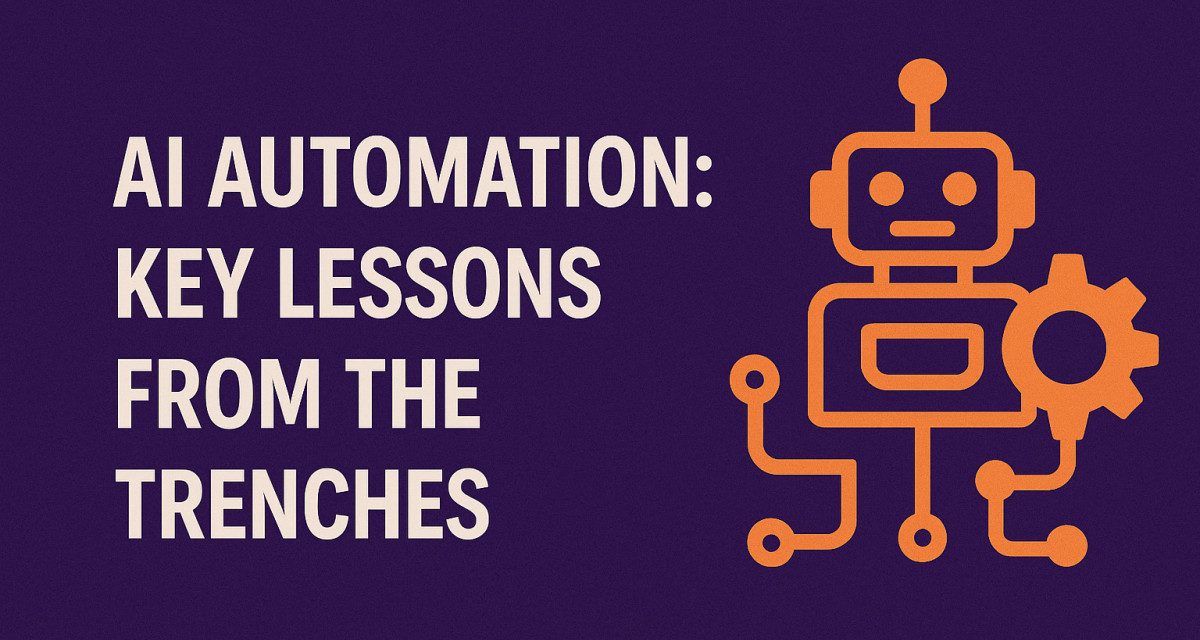What I’ve learned from building real-world AI automation systems that actually work
The AI automation space is moving fast—almost too fast. Every week brings new models, tools, and promises of revolutionary capabilities. But beneath all the hype, what actually works? After analyzing hundreds of hours of tech support calls, client implementations, and real-world deployments, clear patterns emerge about what separates successful AI automation projects from expensive experiments.
The Foundation: Think Like an Architect, Not a Tinkerer
The biggest mistake I see teams make is jumping straight into building without proper planning. Successful AI automation starts with wireframing and visualizing your processes before touching any tools. This isn’t just good practice—it’s essential for managing complexity as your systems grow.
Break everything down into modular, sequential tasks. Your workflow should read like a well-structured recipe, not a tangled mess of dependencies. This modular approach doesn’t just make debugging easier; it dramatically reduces token usage and improves consistency across your entire system.
Consider data flow as your backbone. AI nodes need clean, structured data to function properly, and managing binary data becomes crucial when dealing with files, images, or complex documents. The teams that get this right from the start save themselves weeks of refactoring later.
The Reality of AI Agent Development
Building AI agents that work reliably in production is fundamentally different from creating impressive demos. The difference comes down to three critical areas: prompting, testing, and model selection.
Prompting is both an art and a science. Clear, concise, and reactive prompts consistently outperform verbose instructions. Your prompts should specify tool usage, define output formats (JSON is your friend), and include concrete examples. The agents that work reliably in production have prompts that have been tested and refined dozens of times.
Model selection matters more than most people realize. GPT-3.5 often excels at tool-calling tasks, while GPT-4 and Claude shine for analysis and reasoning. The newer Claude 3.7 shows remarkable improvements in instruction following and handling long outputs. Don’t assume the latest model is always the best for your specific use case.
Memory management becomes your biggest challenge as systems scale. Multi-agent systems quickly hit context limits, forcing you to implement summarization strategies or external storage solutions like PostgreSQL or Pinecone for conversation history.
Data Infrastructure: The Unsexy Foundation of Success
Here’s what no one tells you about AI automation projects: you’ll spend more time on data infrastructure and cleaning than on the AI itself. This isn’t a bug—it’s a feature. The projects that succeed have robust data foundations.
Vector databases are your secret weapon for RAG implementations and maintaining conversation context. Supabase (built on PostgreSQL) offers incredible flexibility with its metadata handling and SQL editor, making it perfect for projects that need both relational and vector data. Pinecone excels when you’re dealing with large-scale unstructured data and need efficient retrieval with namespace organization.
Data comparison and merging become critical when reconciling information from multiple sources. Build these capabilities early, not as an afterthought when inconsistencies start causing problems in production.
N8N: The Dark Horse of Automation Platforms
While everyone talks about Zapier and Make, N8N has quietly become the go-to choice for serious automation work. Its visual workflow editor, open-source nature, and strong community support make it suitable for production-ready backend solutions, despite being labeled as a “prototyping” tool.
The platform evolves rapidly—new features like community nodes and advanced debugging capabilities are constantly being added. This means your learning never stops, but it also means the platform grows with your needs.
Self-hosting N8N offers significant cost savings and complete data privacy control, but requires technical expertise and infrastructure planning. Cloud hosting removes the complexity but at a higher cost. Choose based on your team’s capabilities and security requirements.
Learning N8N effectively means building, not just reading documentation. Focus on mastering core concepts like JSON manipulation, variables, and data flow. The hands-on approach consistently produces better results than theoretical study.
Building a Sustainable AI Services Business
The business side of AI automation is where many technical experts struggle. Client expectations are often unrealistic because they don’t understand AI limitations. Robust discovery calls and detailed scoping documents aren’t optional—they’re survival tools.
Pricing AI projects challenges traditional models. Hourly rates often don’t reflect the value delivered, and fixed prices can’t account for the iterative nature of AI development. Many successful agencies are shifting toward value-based pricing, retainers, or consumption-based models that align better with the actual work involved.
Content creation, particularly on YouTube and LinkedIn, has proven highly effective for attracting qualified leads. When potential clients can see your expertise demonstrated through real examples, sales conversations become consultations rather than pitches.
The most successful agencies focus on specific business pain points rather than trying to automate everything. Small and medium businesses often have “low-hanging fruit”—repetitive tasks that deliver immediate value when automated. Start there, then expand.
Security and Compliance: The Non-Negotiables
GDPR, HIPAA, and other compliance requirements aren’t afterthoughts—they’re fundamental design constraints. Address security and legal compliance in your initial client discussions, not when you’re ready to deploy.
The choice between self-hosting and cloud services often comes down to compliance requirements. Healthcare and financial services clients may require self-hosted solutions, while others prioritize convenience and reliability over complete control.
The Evolving Landscape
The AI industry continues its rapid evolution. New models like Gemini 2.5 Pro, Qwen-2.5, and UI-TARS are constantly emerging, each with unique capabilities and use cases. The shift toward “Results as a Service” and pre-built, customizable solutions is accelerating.
Data ownership and portability are becoming key differentiators. Clients increasingly want solutions that don’t lock them into specific platforms or vendors. Building with this principle in mind future-proofs your implementations.
The demand for professionals skilled in prompt engineering, RAG systems, and vector databases is exploding. These aren’t just technical skills—they’re business capabilities that directly impact client success.
The Path Forward
AI automation is still in its early adoption phase, which means enormous opportunities for those who understand both the technical and business sides. The key is focusing on fundamentals: robust data infrastructure, modular design, thorough testing, and clear client communication.
The teams and agencies succeeding in this space aren’t necessarily the most technically sophisticated—they’re the ones who balance innovation with practical execution. They understand that the goal isn’t to build the most advanced AI system possible, but to create reliable solutions that solve real business problems.
The technology will continue evolving rapidly, but these fundamental principles remain constant. Master them, and you’ll build AI automation systems that don’t just work in demos—they work where it matters most: in production, for real businesses, solving real problems.
Ready to build AI automation systems that actually work? Start with solid foundations, think in modules, and never stop testing. The future belongs to those who can bridge the gap between AI’s potential and business reality.




Recent Comments